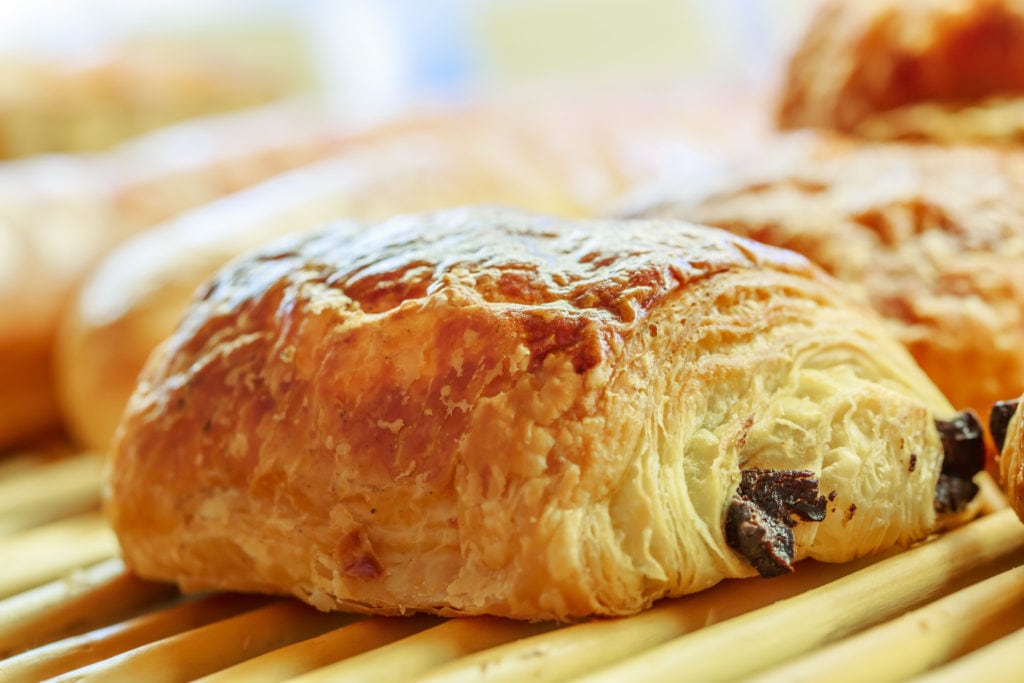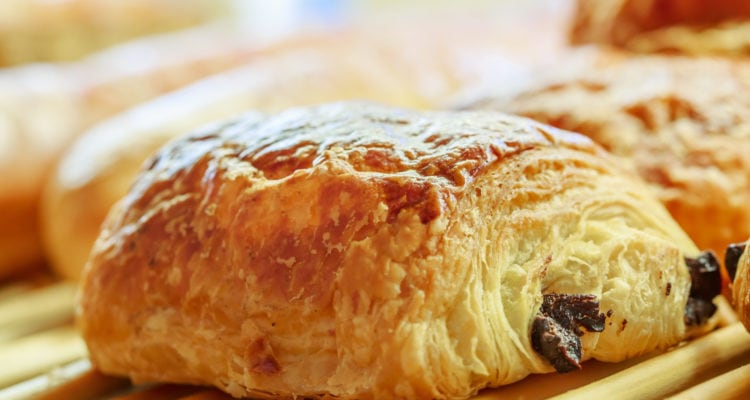
Pain au raisin is a form of French pastry that when translated means raisin bread. But once you have tasted its delicate layers surrounded in creamy fillings and sumptuous raisins, you soon learn that it is so much more than that.
At its base, pain au raisin is a delicate construction of multiple layers of buttery pastry, and it requires many steps of construction. But don’t let the words “pastry” or “multiple steps” freak your out.
Discover here how easy and fun it is to make the French delicacy of pain au raisin.
Understanding Pain au Raisin
Once you understand what pain au raisin is, you will make its multiple steps with ease. Pain au raisin is a pastry much like a French croissant, and it is one that is prepared with a filling.
The multiple steps of this pastry include the construction of the pastry, which requires a lamination stage. Lamination is incorporating butter into a pastry dough and working with it over several hours.
Once you have that stage mastered, you will thoroughly enjoy making pain au raisin again.
After you have constructed the dough, you will then work on the beautiful filling that will have your people’s mouths watering every time you mention the name, pain au raisin. This filling is usually a custard type filling that the French call crème patisserie.
But if you are not ready to become a custard aficionado yet, you can start your French raisin pastry with a beautiful frangipane. Frangipane is just as delicious, and just a little easier.
Prepare your loved ones for a new favorite in the house!
Let’s Start with Frangipane
We will start with frangipane so you know you have this step mastered and ready for use once your pastry is done. Frangipane is much like a pastry crème such as crème patisserie, but it is slightly easier to make and uses almonds as opposed to a rich egg base.
Once you put this together, it becomes a creamy spread that you can add to your pastry dough at the right stage. Be sure you have the 10 baking essentials before you start this complicated process of pain au raisin from beginning to end.
Frangipane is not marzipan, which is also made with almonds. Marzipan is a candy made with icing sugar (or confectioner’s sugar) and becomes paste-like. But frangipane is much smoother and easier to work within things like cakes, breads, and pastries.
Soften your butter overnight for this. You will start with 6.5 tablespoons of butter and one-half cup of granulated sugar.
Three eggs are also used with this recipe, along with one cup of ground almonds, or, almond flour. Add two and one-half tablespoons of all-purpose flour.
Whip the butter and sugar together until it is nice and fluffy. Once you reach this stage, add the eggs one at a time.
We are doing this one at a time to ensure the egg incorporation is nice and smooth. Use a spoon to fold in your almonds and flour, and you have frangipane!
Put that in the fridge until you are ready to construct your pastries.
Pain au Raisin Pastry
The pain au raisin pastry is easy to make. The most time-consuming part of this process is the lamination, but once you have done it once, it gets easier.
Start by chilling one and 1/2 cup of butter overnight in the fridge.
For the pastry, start with 1/2 cup of lukewarm water, 4 teaspoons of yeast, 3 ½ cups of all purpose or pastry flour, and ½ cup milk. You also need 1/3 cup sugar, 3 tablespoons of butter, and ½ teaspoons of salt.
It also requires one egg and two tablespoons of milk.
Start by dissolving the yeast in your warm water for a few minutes. When it rises to the top of the dish and flowers, you know your yeast is “alive” or “active” and ready to use.
Mix together the flour, sugar, butter, salt, milk, and sugar. It’s very important to ensure the salt is incorporated into this mixture before you add the yeast.
Yeast Tips
Bread extraordinaire Paul Hollywood always reminds us that an important thing to remember whenever you are working with yeast is to keep yeast and salt apart when baking. That is because sugar feeds yeast, and salt kills it.
So be sure your salt is well incorporated before adding the yeast.
Now you will incorporate these ingredients and mix until you get a nice and smooth ball of dough. This is not dough that you need to knead to excess, just mix the ingredients until you get a smooth ball.
Put this in the fridge overnight. Now we will get to the tricky part, the lamination stage.
The Butter Sandwich
Lamination is the trickiest part of any French pastry, but it actually sounds trickier than it is. Think of lamination like you are making a butter sandwich with dough, and it is a little easier.
Lamination for pain au raisin is not as complicated as it is for puff pastry, as in, the process is a little shorter. So let’s make our “butter sandwich”, and you can follow my step by step guide to pastry if you get flustered.
Take your dough out of the fridge the next day and roll the chilled dough into a rectangle. Do not let this dough rest as you would when you are making a pie.
Now take some 1 ¼ cup butter and cut into little pieces. Arrange them on a piece of parchment paper and place another piece of parchment on top.
You will roll that with a rolling pin until the butter is flattened. Pound it with the rolling pin if you need to.
Put that in the fridge until it is cooled.
Now you will put that sheet of butter onto the last half of your dough that you just rolled. Fold the top half of the dough over the last half of the dough.
You have your butter sandwich! You will roll this to merge the dough and the butter.
Now chill this dough for another hour or so. Repeat this process twice.
What you are doing here with this is creating the multiple layers that will make your pastry flaky and sumptuous. You will see the layers even before you put the dough back in the fridge overnight.
Now you are ready for the final step! Putting together the pain au raisin!
Pain Au Raisin Springs to Life
For this, you will need your dough, your frangipane, and a few other things. Raisins, one teaspoon of cinnamon, and two eggs will do it.
Take your dough out of the fridge and cut it in half. Roll one half of the dough out to approximately one centimeter thick, or ½ an inch.
Spread half of the frangipane on this dough. Sprinkle raisins and frangipane over this section.
Roll that dough as if you are rolling a towel. Do the same thing with the other half of dough.
Now you will cut those into slices for the size of pain au raisin that you want. Lay them all in a greased baking sheet or tray with the cut side facing up.
Remember this is a yeast dough, and you need to let this beautiful pastry rise for about two hours.
When ready, brush these beautiful delights with an egg wash, and bake in the oven for approximately 20 minutes at 400 F, or until they are a golden brown.
Congratulations! You just made French pastry!
Create Your Slice of Heaven With Ease
The most important thing when you are baking pastry such as pain au raisin is to not freak out. There are multiple steps to this recipe, which is a combination of a few recipes.
With every step, you are probably thinking, “I want this to be perfect.” Don’t think that way!
Instead, think about how much fun you are having learning this wonderful new set of recipes, and pulling them all together. The prize for you is pulling your delicious pain au raisin out of the oven and serving them to the people you love.
But they don’t have to look perfect. And they don’t even have to taste perfect. They are homemade — made with love!
They just need to taste like the love that you poured into them. Have faith that you will perfect this recipe because once you taste your first batch, you’ll begin planning your next one, so good are these treats.
Your first pain au raisin will never be perfect, and that’s the beautiful thing about the science of baking. You learn something new with every batch.
Even I do! And I bake pastry and other wonderfully delicious things for a living. Contact a professional baker for tips and tricks to perfect your pain au raisin today.


Comments